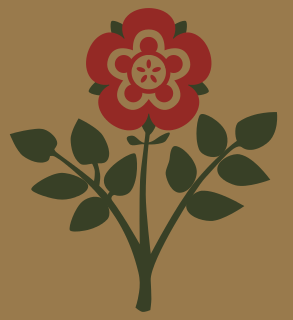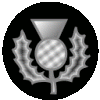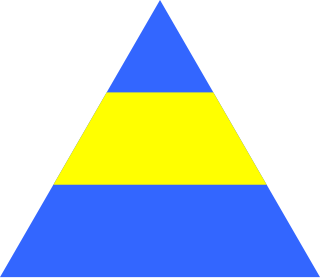
The 48th Division was an infantry division of the British Army. Part of the Territorial Force (TF) and raised in 1908, the division was originally called the South Midland Division, and was redesignated as the 48th Division in 1915. During the First World War, the division saw service on the Western Front before being transferred to the Italian Front in November 1917 and remaining there for the rest of the war.

The 55th Infantry Division was an infantry division of the British Army's Territorial Army (TA) that was formed in 1920 and existed through the Second World War, although it did not see combat. The division had originally been raised in 1908 as the West Lancashire Division, part of the British Army's Territorial Force (TF). It fought in the First World War, as the 55th Division, and demobilised following the fighting. In 1920, the 55th Division started to reform. It was stationed in the county of Lancashire throughout the 1920s and 1930s, and was under-funded and under-staffed. In the late 1930s, the division was reduced from three to two infantry brigades and gave up some artillery and other support units to become a motorised formation, the 55th Motor Division. This was part of a British Army doctrine change that was intended to increase battlefield mobility.

The Home Counties Division was an infantry division of the Territorial Force, part of the British Army, that was raised in 1908. As the name suggests, the division recruited in the Home Counties, particularly Kent, Middlesex, Surrey and Sussex.

The 9th (Highland) Infantry Division was an infantry division of the British Army, formed just prior to the start of the Second World War. In March 1939, after the re-emergence of Germany as a significant military power and its occupation of Czechoslovakia, the British Army increased the number of divisions in the Territorial Army (TA) by duplicating existing units. The 9th (Highland) was formed in August 1939, as a second-line duplicate of the 51st (Highland) Infantry Division. The division's battalions were all raised in the Scottish Highlands.

The 66th Infantry Division was an infantry division of the British Army, which was active between September 1939 and June 1940 during the Second World War. In March 1939, after the re-emergence of Germany as a European power and its occupation of Czechoslovakia, the British Army increased the number of divisions within the Territorial Army by duplicating existing units. The 66th Infantry Division was formed in September 1939, as a second-line duplicate of the 42nd Infantry Division. The division's battalions were all raised in the Lancashire and Cumbria area.

The 76th Infantry Division was an infantry division of the British Army, which was formed in November 1941 and served during the Second World War. It was created when the Norfolk County Division, initially raised in 1940 to defend the Norfolk coast from a potential German invasion, was redesignated. The division maintained the defensive duties that had been assigned to it, prior to it being renamed, until late 1942 when it became a training formation. It was then responsible for providing final tactical and field training to soldiers who had already passed their initial training. After five additional weeks of training, the soldiers were posted to fighting formations overseas. The formation was used as a source of reinforcements for the 21st Army Group, that was fighting in the Normandy campaign. After all available British troops had left the United Kingdom for France, the division was disbanded in September 1944.

The 59th (Staffordshire) Infantry Division was an infantry division of the British Army that was formed during the Second World War and fought in the Battle of Normandy. In March 1939, after Germany re-emerged as a significant military power and occupied Czechoslovakia, the British Army increased the number of divisions in the Territorial Army (TA) by duplicating existing units. The 59th (Staffordshire) Motor Division was formed in September 1939, as a second-line duplicate of the 55th Motor Division. The division's battalions were all, initially, raised in Staffordshire.

The 45th Infantry Division was an infantry division of the British Army, formed just prior to the start of the Second World War. In March 1939, after the re-emergence of Germany as a significant military power and its occupation of Czechoslovakia, the British Army increased the number of divisions in the Territorial Army (TA) by duplicating existing units. The 45th started forming in August 1939 and became active the following month, as a second-line duplicate of the 43rd (Wessex) Infantry Division. The division's battalions were all raised in the West Country.

The 47th (London) Infantry Division was an infantry division of the British Army that was formed during the Second World War and remained in the United Kingdom until the end of the war. In March 1939, after the re-emergence of Germany as a significant military power and its occupation of Czechoslovakia, the British Army increased the number of divisions in the Territorial Army (TA) by duplicating existing units. The 2nd London Division was formed in August 1939 as a second-line duplicate of the 1st London Division; its battalions were all initially London-based.

The 77th Infantry Division of the British Army was formed in 1941, during the Second World War, from the re-organisation of the Devon and Cornwall County Division. During its existence the division changed roles several times. The division's initial role was coastal defence, protecting Devon. On 20 December 1942, it was converted into a training formation, known as a reserve division. In this capacity, the division provided final tactical and field training for the infantry that had already passed their initial training. After five additional weeks of training, the soldiers would be posted to fighting formations overseas. The division also had a tank brigade attached to provide training in armoured warfare.

The 61st Infantry Division was an infantry division of the British Army, raised in 1939 as part of the expansion of the Territorial Army in response to the German occupation of Czechoslovakia. The division was created as a duplicate of the 48th Infantry Division, and was assigned to home defence duties.

The 55th Division was an infantry division of the British Army's Territorial Force (TF) that saw extensive combat during the First World War. It was raised initially in 1908 as the West Lancashire Division. Following the outbreak of the First World War, in 1914, the majority of the division's men volunteered for overseas service. Those who did not volunteer were used to form new reserve units, and on 31 August 1914 these units were used to create the 2nd West Lancashire Division. Rather than being deployed as a whole formation, the West Lancashire Division was broken up during 1914 and 1915 as its units were dispatched piecemeal to the Western Front. As each unit left, it was replaced by a reserve unit. When the last unit of volunteers for overseas service departed, the remnant of the division was amalgamated with the 2nd West Lancashire Division, and the West Lancashire Division ceased to exist.
The 134th Infantry Brigade was an infantry brigade of the Territorial Force, part of the British Army. It was formed in the First World War as a duplicate of the Hampshire Brigade and was originally formed as the 2nd/1st Hampshire Brigade in 1914–1915 before later being renamed as the 134th Brigade. It was sent overseas to India in December 1914 to relieve Regular Army units for service in France. The brigade remained there for the rest of the war, supplying drafts of replacements to the British units fighting in the Middle East and later complete battalions. By September 1917 the last of its battalions had departed.

The 12th (Eastern) Infantry Division was an infantry division of the British Army, which fought briefly in the Battle of France during the Second World War. In March 1939, after the re-emergence of Germany as a European power and its occupation of Czechoslovakia, the British Army increased the number of divisions within the Territorial Army by duplicating existing units. The 12th (Eastern) Infantry Division was formed in October 1939, as a second-line duplicate of the 44th Infantry Division.
The Preston Rifles, later the 4th Battalion, Loyal North Lancashire Regiment, was a volunteer unit of the British Army from 1859 until the 1950s. It served as infantry on the Western Front and in Ireland during the First World War, and as an air defence unit during The Blitz and the campaign in North West Europe during the Second World War.
The Bolton Rifles, later the 5th Battalion, Loyal North Lancashire Regiment, was a volunteer unit of the British Army from 1859 until 1967. It served on the Western Front during the First World War, and in the Far East during the Second World War, when one battalion was captured at the Fall of Singapore.

The 3rd West Lancashire Artillery was a volunteer unit of Britain's Territorial Force recruited from Liverpool that saw action during the First World War, distinguishing itself at the Battle of the Avre. During the Second World War, it served in the air defence and medium artillery roles at home and in the Far East. Its successor unit continues to serve as a battery in the modern Army Reserve.














